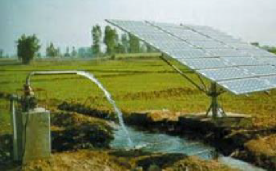Tube Wells
A tube well is a deeper well (generally over 15 metres deep) from which water is lifted with the help of a pumping set operated by an electric motor, a diesel engine or solar power.

Figure: Tube Well Irrigation
In several areas, the ‘persian wheel’ earlier used for lifting water has been replaced by tube wells.
A tube well cannot be constructed everywhere and requires some geographical conditions favouring its installation, such as:
♤ There should be sufficient quantity of ground water because a tube well can generally irrigate 2 hectares per day against
0.2 hectares per day irrigated by an ordinary well.
♤ The water level should be nearly 15 metres. If the water table is more than 50 metres deep the cost of pumping out water from the tube well becomes uneconomic.
♤ There should be regular supply of cheap electricity or diesel so that water from the tube well can be taken out at the hour of need.
♤ The soil in the immediate neighbourhood of the tube-well should be fertile so that there is demand for irrigation and the cost involved in the construction and operation of the tube well can be recovered by the increased farm production.
